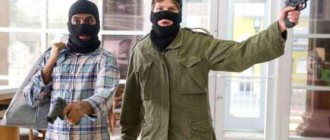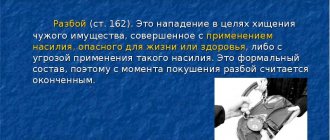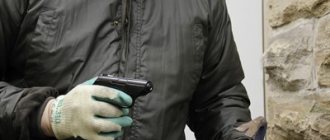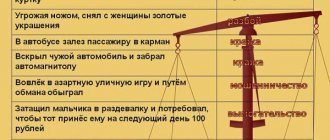Robbery is an attack under Art. 162 of the Criminal Code of the Russian Federation, committed:
- for the purpose of stealing someone else's property,
- with the use of violence dangerous to life or health,
- or with the threat of such violence.
In the article we will consider the features of qualification and sentencing for robbery:
- committed by a group of persons by prior conspiracy,
- without prior agreement,
- committed as part of an organized group.
Committed by a group of persons
Responsibility for robbery is provided for in Article 162 of the Criminal Code of the Russian Federation (CC RF). Part 2 of this article prohibits the commission of robbery by a group of persons by prior conspiracy, and part 4 - by an organized group.
- What liability in this case is provided for the commission of robbery by a group of persons without prior agreement?
Part 1 of Article 35 of the Criminal Code of the Russian Federation states that if two or more co-perpetrators did not have a prior conspiracy to commit a crime, then such a crime is recognized as committed by a group of persons.
A perpetrator is a person who either independently and directly, or together with others (in which case they will be called co-perpetrators) committed a crime.
Example:
If Ivan saw Sergey beating Anatoly, came up and joined in the beating, as a result of which Anatoly suffered a short-term health disorder, then Ivan and Sergey become co-perpetrators of intentional infliction of minor harm to health.
- Another situation: if the person did not directly commit the crime.
If a person did not commit a crime directly, but used other persons not subject to criminal liability (minors, insane) to commit it, then such a person will still be recognized as a perpetrator.
Example:
Victor promises a reward to a twelve-year-old teenager for threatening to stab the victim in the liver, take his bag from him and bring it to the specified person.
Victor realizes that criminal liability for robbery begins at the age of 14, which means, in his opinion, neither the teenager (after all, he is only 12 and is not subject to criminal liability), nor himself (after all, he himself did not threaten the victim and did not strike ) nothing is in danger.
However, the Criminal Code, in Part 2 of Article 33, clearly classifies such persons as perpetrators of a crime.
The same explanations are given by the Plenum of the Supreme Court of the Russian Federation in paragraph 12 of Resolution No. 29 of December 27, 2002. Indeed, the commission of robbery by a group of persons without prior agreement is not a qualifying feature of this crime. Consequently, for each of the co-perpetrators this act will be qualified under Part 1 of Article 162 of the Criminal Code of the Russian Federation.
Question:
— Is it really impossible for the court to take into account the fact that the robbery was committed not by one person, but by at least two, even if they had no prior agreement?
Answer:
- Of course it can. The Plenum recommends that this fact be considered an aggravating circumstance (clause “c” of Part 2 of Article 63 of the Criminal Code of the Russian Federation).
Recommended reading:
Robbery investigation techniques
The difference between robbery and other related compounds
Robbery: analysis of the Resolution of the Plenum of the Supreme Court No. 29
DEFINITION
Case No. 21-O12-4
dated August 29, 2012
consisting of:
examined at a court hearing on August 29, 2012 a criminal case based on cassation complaints from the convicted Khokonov AA and lawyers Golitsina I.B., Boriev CA. and Kochesokova Z.A. on the verdict of the Supreme Court of the Kabardino-Balkarian Republic dated May 5, 2012, according to which
=>
[hidden] unconvicted,
sentenced to imprisonment: under paragraph “c” of Part 4 of Art. 162 of the Criminal Code of the Russian Federation (as amended by the Federal Law of the Russian Federation dated December 27, 09) for 9 years with restriction of freedom for 1 year (restrictions are given in the sentence); according to paragraph “h”, part 2, art. 105 of the Criminal Code of the Russian Federation (as amended by the Federal Law of the Russian Federation dated December 27, 09) for 15 years with restriction of freedom for 1 year (the restrictions are given in the sentence), and on the basis of Part 3 of Article 69 of the Criminal Code of the Russian Federation for a total of crimes for 16 years of imprisonment freedom in a maximum security correctional colony, with restriction of freedom for 1 year 6 months (restrictions are given in the sentence),
And
Khokonov A
unconvicted
convicted under Part 3 of Art. 162 of the Criminal Code of the Russian Federation (as amended by the Federal Law of the Russian Federation dated December 27, 09) for 8 years of imprisonment in a maximum security correctional colony, with restriction of freedom for 1 year (restrictions are given in the sentence).
Having heard the report of judge Valyushkin V.A., the explanations of the convicted Khokonov AA, Khokonov PP and in their defense, respectively, lawyers Bitsaev V.M. and Lunin D.M., who supported the complaints, the opinion of prosecutor Titov N.P., who believed that there were no grounds for canceling or changing the sentence, the judicial panel
installed:
by a court verdict, Khokonov A. and Khokonov R. were found guilty of attacking [hidden] Shch for the purpose of stealing someone else's property, with the use of violence dangerous to life and health, by a group of persons by prior conspiracy, with the use of weapons and objects used as weapons, with illegal entry into a home, and Khokonov A. and with causing grievous harm to health [hidden] as well as intentionally causing her death, associated
wife with robbery.
These crimes were committed on August 22, 2010 in the village. [hidden] district [hidden] of the Republic under the circumstances set out in
sentence.
At the court hearing, A. Khokonov partially admitted his guilt, that is, that he attempted theft, and as for the pistol shots, they were fired accidentally. Khokonov R. did not admit guilt, stating that he was not involved in the crime.
In cassation appeals:
- Convict Khokonov A., considering the verdict illegal, unfounded and unfair, indicates that his theft of property was not completed and there was a voluntary refusal to commit it, which was not taken into account by the court when imposing the punishment. In addition, it indicates his lack of intent to take life. Believes that his actions should be qualified under Part 3 of Art. 109 and Art. , , 162 of the Criminal Code of the Russian Federation. Considers the imposed punishment to be excessively harsh. In connection with the above, he asks either to cancel the sentence, sending the case for a new trial, or to change it, correctly qualifying his actions and reducing the punishment;
- Golitsin’s lawyer in defense of A. Khokonov, disagreeing with the verdict, considers it illegal, unfounded, decided without taking into account the circumstances
laws established in court, affecting the qualification of crimes and the punishment. In support of these arguments, she points out that the testimony [hidden] underlying the conclusion that her client is guilty of premeditated murder is inconsistent, contradictory, and does not agree with other evidence, in particular, with the expert’s explanations, with the conclusions of the forensic medical examination. The verdict does not assess the defense's arguments about the presence of significant contradictions in the evidence obtained in the case, which indicates violations were committed, in particular, during the inspection of the scene of the incident, according to which 4 bullets were found in the courtyard of the victim's house, which is not consistent with the testimony [hidden] expert opinion . Arguments of the defense, isn’t it
The compelling reasons that Khokonov A. lacked intent to kill, and that he committed murder through negligence, have not been refuted. The reference to A. Khokonov’s testimony during the investigation is illegal, since it was obtained from him as a result of the use of illegal methods, as a result of physical violence. The reference to the verdict in relation to [hidden] is also unconvincing, while the complaint puts forward and substantiates the version according to which the case in relation to [hidden] is specially separated into separate proceedings. At the same time, the complaint points out that in the verdict the court did not indicate the repentance of her client, his apology to the victims, and ignored the behavior of A. Khokonov after the incident, who spoke about an accidental shot, cried, and regretted what happened. Therefore, the punishment is excessively harsh. He asks that the verdict be overturned and the case sent for a new trial.
- lawyer S.A. Boriev in defense of the convicted Khokonov, R. only stated that the sentence was illegal and unfounded;
- the main and additional lawyer Kochesokov in defense of R. Khokonov.
considers the verdict illegal, unfounded, subject to cancellation due to the discrepancy between the court's conclusions and the actual circumstances of the case, and also unfair. The verdict is based on contradictory evidence, in particular, the testimony of A. Khokonov and [hidden] which they gave during the investigation and in court, for-
interested in reducing their role in crimes. According to the testimony of [hidden] - [hidden] she saw two attackers, which was confirmed in court by A. Khokonov.
In addition, witnesses [hidden] L. testified about
that his client was in a different place at the time of the crime. When checking the testimony [hidden] during the investigation, two mask hats were discovered.
His client’s testimony of innocence has not been refuted; based on his testimony during the investigation, he had no intent to commit robbery. The reference to the verdict in relation to [hidden] is also illegal, since this verdict was overturned. Due to an incorrect assessment of the evidence, the use of inadmissible evidence, he asks for the verdict to be either canceled and the case sent for a new trial, or terminated for lack of involvement in the crime.
The prosecutor filed objections in which he considers the arguments to be convicted
nogo and lawyers are unconvincing and asks to leave them without satisfaction.
Having checked the case, having discussed the arguments of the convict, the lawyers and the prosecutor’s objections to them, the judicial panel finds that the court’s conclusion that A. Khokonov is guilty of robbery and murder, and R. Khokonov of robbery, corresponds to the factual circumstances of the case and is based on the totality of those examined during the trial evidence given in the verdict.
The arguments contained in the cassation appeals about the non-involvement of Khokonov R. in the crime, and in relation to Khokonov A., that he committed attempted theft and causing death by negligence, are similar in essence to the arguments that were put forward during the trial, and which were reasonably recognized unconvincing.
Thus, according to the testimony of A. Khokonov, during the investigation in June 2010, [hidden] said that he knew a house where about [hidden] rubles were kept in a safe, and
offered to kidnap them, and then said that the owners would soon leave for the sea, showed the house, explained where the safe was. He told this to his cousin [hidden] who agreed to participate in the theft. In August B Reported,
that the owners have left and we need to act. The three of them arrived at the house. There he made himself a mask from the sleeve of his jacket, gave the second sleeve to [hidden] and [hidden] was already with the mask. Armed with a traumatic pistol "OSA" and an object similar to a bat, they entered the yard, [hiddenly] took them under a canopy, where in the dark they came across a bed, and the woman who was on it began to scream and call for help. [hidden] and [hidden] rushed towards her, [hidden] covered her mouth with his hand, and began to strike her with a bat. He also ran up to the woman and shot her. The screams stopped. [hidden] saw through the window that someone was walking in the house, and the two of them rushed to the door, blocked it, blocking the exit from the house. At the same time, [hidden] pinched his hand in the door, and, pulling it out, he shot three times. After that, they ran away, and the next morning he learned from people that a woman had been killed, and at the request of several people, he took them to the house where they had previously committed the crime.
During the investigation, R. Khokonov confirmed the existence of a conspiracy to steal a safe with money, and that upon arrival at the house [hidden] the three of them put on their faces
masks, gloves, and Khokonov A (had a traumatic pistol.
At a confrontation with A. Khokonov, R. Khokonov, having clarified some circumstances, nevertheless confirmed his participation in the crime.
At the court hearing, Bogotov, who had previously been convicted of the same crime, confirmed that three people entered the yard [hidden], that is, he and the Khokonov brothers, and the “taxi driver” remained outside.
According to his testimony at the investigation, A. Khokonov shot a woman in the head who was lying on a bed under a canopy, and then fired a pistol three more times in the direction of the house where there was a girl. The third guy who took part with them had a baton with him, which he accidentally left in the yard of LI I. According to a previously reached agreement, he was wearing a mask and gloves when committing the crime.
During an investigative experiment with the participation of Bogotov, he reproduced the circumstances of the crimes on the spot, and, in addition, in the place he indicated, two mask hats and a pair of gloves used in the commission of crimes were found.
As follows from the testimony of a witness [concealed], after a woman’s scream and
arrows from the side of the household [hidden] she saw three people running
the guys pass her at high speed.
From the testimony of the victim [hidden] it follows that he was on vacation at sea, and
on the morning of August 22, he received a call and was informed that three masked men had broken into the house and killed his wife. Upon arrival home, I learned from my daughters the circumstances of what happened. Before that, Bogotov [hidden] worked for them for two months, whose wife subsequently told him that A. Khokonov, having learned that his wife had died, threatened over the phone [hidden] that if he told about him, he would “remove” him and son.
The victim Ash [hidden] confirmed that when she heard a noise in the yard,
tried to leave the house, an unknown man in a mask shot several times in her direction. When the attackers fled, she found her mother with a bloody head under the canopy on the bed. There was a club next to the mother. The arriving doctors confirmed the death of the mother. She was taken to the hospital, where she received medical care for her injuries.
Witness [hidden] (maiden name -1 [hidden), gave similar testimonies
knowledge, adding that the attackers were wearing masks, she saw two people at the door. Under the canopy they found the mother, who was covered in blood. When police officers arrived, they found a baton and rubber balls in the yard.
As can be seen from the protocol of the inspection of the scene of the incident under a canopy in a household on the street. [hidden] in the city [hidden] a corpse was discovered [hidden] with signs of violent death. A wooden baton and four objects similar to bullets from an OSA traumatic pistol were found in the yard.
According to the conclusion of the forensic medical examination, the cause of death was
[hidden] there was a blind bullet gunshot wound to the head with damage
loss of the frontal bone with contusion of the frontal lobe of the left hemisphere of the brain, with
focal subarachnoid hemorrhages, complicated by cerebral edema, resulting from a close-range shot from a firearm with a bullet projectile with a diameter of 10-15 mm. She was also found to have a hip injury caused by a hard, blunt object with a limited impact area, or by being hit by one, including, not excluded, a fall from her own height.
According to the conclusion of the forensic medical examination, [hidden] has
There are: a gunshot tangential wound to the neck on the right, a gunshot tangential wound to the occipital region on the left, a gunshot blind wound and bruise of the left thigh, bruises of the left shoulder. The described injuries were caused by the action of hard, blunt objects with significant force and a limited area of impact (which could be bullets fired from a traumatic weapon). In terms of severity, they are classified as causing minor harm to health based on the duration of the disorder for up to 21 days.
During the investigation, a traumatic pistol “OSA-Lazer” series [hidden] was confiscated from A. Khokonov, which, as follows from the expert’s report -
The ballista is a barrelless traumatic weapon OSA-PB4-1-ML series [hidden] of 18×45 mm caliber, designed for firing traumatic cartridges with rubber bullets of 18×45 mm caliber. This weapon is suitable for firing shots. The 4 rubber objects submitted for examination, seized during the inspection of the crime scene, are rubber bullets for loading traumatic cartridges of 18×45 mm caliber, intended for firing from traumatic weapons of 18×45 mm caliber (OSA, etc.). These rubber bullets could have been fired from the above-mentioned traumatic weapons.
During the trial, the arguments in defense of R. Khokonov about his non-involvement in the crime, and the presence of an alibi with references to the fact that, according to the testimony of the victims, they saw two, and not three, attackers, that only two hats-masks were found, etc., were carefully checked. etc., which were reasonably found to be unconvincing on the grounds set out in detail in the verdict.
The testimony at the preliminary investigation and at the court hearing of the Khokonovs and Bogotov, each on its own, did not have any advantage over the rest of the evidence, and was assessed by the court in conjunction with all the information obtained in the case, while the verdict provided the reasons why the court took into account some and rejected other testimonies of these persons.
The panel of judges cannot agree with the arguments contained in the cassation appeals that the verdict was based on flawed evidence, since not a single piece of evidence whose legal force was in doubt was used to support any of the court’s conclusions.
The commission of a robbery, and not an attempted secret theft, as indicated in the complaints in defense of A. Khokonov, is evidenced by the nature of the actions of the convicts established by the verdict, both at the preparatory stage of the crime and at the time of its commission, their use of gloves, masks, as well as the presence of a traumatic pistol and a bat, of which all participants in the attack were aware and assumed the possibility of using a weapon and a bat to attack and suppress resistance.
The fact that the attackers did not take possession of the funds does not exclude their responsibility for the robbery, which is considered completed from the moment of the attack itself.
The argument in defense of A. Khokonov about the presence of negligence in his actions when firing a shot that led to death [hidden] is also unconvincing, since it is refuted not only by Bogotov’s testimony,
testifying about A. Khokonov’s aimed shot at the victim’s head, but also the expert’s conclusion that the shot to the head was fired at close range.
The arguments of the convict and lawyers that the failure of the investigative bodies to carry out certain investigative actions, the court’s rejection of a number of petitions, led to the imposition of an unfounded verdict, are also untenable, since the court, having comprehensively, fully and objectively examined the circumstances of the case, checked the evidence, and compared them with each other , having assessed the collected evidence in its entirety, came to a reasonable conclusion about its sufficiency to resolve the case, and, having checked all the versions in defense of the convicts and refuted them, found Khokonov A. and Khokonov R. guilty of committing the crimes incriminated against them, giving the crime to Khokonov A - correct legal assessment.
The fact that the investigation did not find the third hat-mask, did not establish the identity of the two masks found, and did not clarify the circumstances of the discovery of 4 bullets at the scene of the incident, this in no way casts doubt on the validity of convicting the Khokonovs for their crime.
When sentencing Khokonov A., the court fully took into account the nature and degree of public danger of the crime, information about his personality, and all the specific circumstances of the case. The punishment imposed on him meets the requirements of Art. , the Criminal Code of the Russian Federation, is proportionate to the crime and fair. The panel of judges finds no reason to consider it excessively harsh, and therefore this argument in defense of A. Khokonov is unfair.
There are no violations of the law that constitute grounds for overturning the sentence.
At the same time, the sentence against R. Khokonov is subject to change,
since the nature of his actions when committing a robbery testifies not to the violence he used, dangerous to the life and health of the victim, but to the threat of using such violence.
The changes made in relation to Khokonov R. are the basis for mitigating the punishment, when assigning which, the court fully took into account the nature and degree of public danger of what he did, data about his personality, and all the specific circumstances of the case.
Based on the above, and guided by Art. 377, 378, 388 Code of Criminal Procedure of the Russian Federation, judicial board
By prior agreement
The definition of a crime committed by a group of persons by prior conspiracy, which is presented in Part 2 of Article 35 of the Criminal Code of the Russian Federation, contains a key feature that allows it to be distinguished from a crime that was committed by a group of persons.
Important! If persons have agreed in advance to jointly commit a crime, then the crime they commit will be a crime by a group of persons by prior conspiracy.
Let's look at an example:
Anton, Boris and Vladimir decided to commit a robbery against Yuri, entering his apartment and threatening him with violence with a weapon (the gun was an imitation, but made so well that it was impossible for a non-professional to distinguish it from the real thing).
According to the developed plan, Anton was supposed to break into the door lock of the apartment and, while Boris threatens Yuri, remove his wife’s personal computer, laptop and jewelry box from his apartment.
Vladimir’s role was as follows: to stand near the entrance to the entrance, make sure that none of the passers-by saw Anton loading the stolen property into the car, and then take away all the things and hide them at his dacha.
How should the actions of each of the heroes in the given situation be qualified?
In order to give the correct answer to the question posed, it is necessary to understand that if:
- persons agreed in advance to commit robbery,
- a plan was developed to commit the robbery, roles were assigned in accordance with this plan,
- BUT! the confiscation of property from the victim was carried out only by one of the parties to the agreement,
then such an act for each of them must be qualified by the court as robbery committed by a group of persons by prior conspiracy. In this case, additional qualifications under Article 33 of the Criminal Code of the Russian Federation (types of accomplices in a crime) are not required; each of them is a co-principal.
Let's consider a few additional situations:
- About complicity.
Let's introduce a new hero into the proposed situation - Gregory.
Grigory was not at the scene of the crime, did not break into the apartment’s lock, and did not even wait for accomplices at the dacha; but at the same time, he was closely acquainted with Yuri and told Anton, Boris and Vladimir that he and his wife kept all their jewelry in a box that stood in the hallway, and there was a cylinder lock on his door.
— Will Grigory be an accomplice in the crime?
- Yes.
— Will Gregory be a co-executor?
- No.
Since Gregory did not directly participate in the theft of someone else's property, but only assisted in the commission of the crime (he gave advice and instructions), he will be an accomplice.
This means that when qualifying his actions, the court should refer to Part 5 of Article 33 of the Criminal Code of the Russian Federation.
- About responsibility only for those actions that are committed personally.
Let’s imagine that at the time of the robbery in the situation under consideration, Dmitry was coming down the stairs, became interested in what was happening and decided to take an active part in the robbery. He took the plasma TV out of Yuri's apartment and took it to his own apartment.
Paragraph 11 of the previously mentioned PPVS states that Dmitry should bear criminal liability only for actions committed by him personally. This means that the classification of robbery committed by a group of persons by prior conspiracy in relation to Dmitry is impossible.
- About the performer's excesses.
In the same case, if Boris, going beyond the pre-drawn up plan, took a real pistol with him and, at the moment when Yuri began to resist, shot the victim in the head, the excess of the performer will be evident.
Reference. The perpetrator's excess is the commission by the perpetrator of a crime that is not covered by the intent of other accomplices (Article 36 of the Criminal Code of the Russian Federation)
In this case, Anton and Vladimir will be held responsible only for the robbery committed. In addition, responsibility for the murder will be borne only by the one who committed the murder - Boris.
According to Article 36 of the Criminal Code of the Russian Federation, accomplices should not be held criminally liable for committing an action that was not covered by their intent.
Position of the defense on charges of robbery (Article 162.2 of the Criminal Code of the Russian Federation)
Position of the defense on the charge under Article 162.2 of the Criminal Code of the Russian Federation
in accordance with Part 2 of Article 273 of the Code of Criminal Procedure of the Russian Federation
On May 29, 2015, the Savelovsky District Court received materials from the case accusing the defendant of committing a crime under Part 2 of Article 162 of the Criminal Code of the Russian Federation.
The defendant is charged with robbery, namely that on December 1, 2014, she, in complicity with an unidentified person, in the Golden Babylon shopping center, no later than 20:08, attacked the seller, and, threatening her with an object similar to a knife, stole she has money in the amount of 200,000 rubles.
We believe that the defendant’s commission of a crime under Part 2 of Article 162 of the Criminal Code of the Russian Federation was not proven by the prosecution, was not confirmed during the trial, and was not established by the circumstances of the case.
According to paragraph 1.2, part 1, article 73. The Code of Criminal Procedure of the Russian Federation in criminal proceedings requires proof of:
- crime event (time, place, method and other circumstances of the crime);
- the guilt of a person in committing a crime, the form of his guilt and motives.
According to Part 1 of Art. 14 of the Criminal Code of the Russian Federation, a crime is recognized as a socially dangerous act committed guilty of guilt, prohibited by the Criminal Code of the Russian Federation under threat of punishment.
According to Article 8 of the Criminal Code of the Russian Federation, the basis for criminal liability is the commission of an act containing all the elements of a crime provided for by the Criminal Code of the Russian Federation.
1) From the objective side, robbery is expressed as an attack with the aim of stealing someone else’s property, committed with the use of violence dangerous to life and health, or with the threat of such violence. The main elements of the disposition of Art. 162 of the Criminal Code are:
- attack;
- associated with violence dangerous to life and health or with the threat of its use;
- for the purpose of stealing someone else's property.
By virtue of Article 73 of the Criminal Code of the Russian Federation, during the proceedings, it must be proven that the defendant committed precisely the specified actions.
However, as follows from the indictment, the defendant’s actions consisted of the fact that she “arrived at the shopping center... entered the premises of the shopping pavilion... received money from the victim in the amount of 200,000 rubles,” after which she left the shopping pavilion. This is exactly how the objective side of the defendant’s actions is described both in the decision to bring her as an accused, and in the decision to bring charges and in the indictment.
During the trial, the prosecution never presented evidence that the defendant attacked Biryukova using violence or threatening to use it.
Moreover, the fact that Artemova did not threaten the victim is indicated by the victim herself, who, during interrogation on June 24, 2015, stated that the defendant did not use violence against her, did not threaten her in any way, and she handed over the money to her with her own hand and voluntarily.
The testimony of the victim, given at the court hearing on June 24, 2015, about the threats of violence made against her did not concern the defendant, but a certain man, allegedly her accomplice, who, however, was not identified by the investigation. According to her, it was he who, being alone with Biryukova, expressed to her the threat “it won’t seem like much” and at the moment when he said this, Biryukova saw an object similar to a knife in the inner pocket of his jacket.
At the same time, the only source of information about both the threats to the victim from the man and about the presence of a knife in his possession is the testimony of the victim herself. These statements are not supported by any other evidence.
However, is it possible to completely trust the testimony of the victim, who states that during the events taking place she was in an unconscious state, acted, in her words, “as if in a fog,” and “did not understand anything”? Based on this, can it be reliably stated that the victim actually saw “an object similar to a knife” in the inside pocket of the man’s jacket? Moreover, the victim describes this object itself in completely different ways: in her initial testimony, this object has the shape of a kitchen knife, but later, in a confrontation with the defendant, she claims that this object looks like a stationery knife!
Thus, we believe that from the objective side, the defendant’s actions towards the victim, expressed in the fact that she accepted money from her and gave her microchips in return, cannot be qualified as an assault under Part 2 of Article 162 of the Criminal Code of the Russian Federation.
2) Based on the above, we believe that the prosecution has not proven that the defendant is guilty of committing a robbery . From the subjective side, robbery is characterized by guilt in the form of direct intent: the perpetrator realizes that he is committing an attack coupled with violence dangerous to the life or health of the victim, or with the threat of such violence, and wants to commit such an attack.
The materials of the case do not establish that the defendant had the intent to commit a robbery. Moreover, the prosecution does not provide any evidence of any criminal intent on the part of the defendant.
The parties to the trial have no disagreement about whether Artyomova’s actions themselves took place at the specified time in the specified place: both the defendant and the victim unequivocally claim that their meeting took place and that the victim gave money to the defendant, and she gave her microchips in return.
However, why did they perform these actions? What goal did both the victim and the defendant pursue? – this has not been established by the prosecution.
There are two opposing versions of this in the case materials.
According to the defendant, the only purpose of her meeting with the victim and giving her the microcircuits was to fulfill her acquaintance Igor, for which he promised her a reward in the amount of 5,000 rubles.
According to the prosecution, the defendant’s goal was to forcibly steal other people’s property. However, the prosecution did not provide evidence of this, and therefore this version remained only a hypothesis until the end of the judicial investigation.
3) The same hypothesis of the prosecution is the information about the existence of a criminal conspiracy to commit a robbery between the defendant and the unidentified man under investigation. This hypothesis is not supported by any evidence.
The fact that the unidentified man was an acquaintance of the defendant is confirmed by both herself and her neighbor. in the testimony given by him during interrogation on June 6, 2015. However, there is not a single piece of evidence indicating that the defendant, together with this or any other man, conspired to commit a robbery in the shopping center.
Moreover, the defendant herself characterizes her intentions completely differently, explaining that she was carrying out the instructions of a man who offered her to give the victim microcircuits for a fee.
It is worth noting that while carrying out the assignment, the defendant has nothing to do with the plan that the man is implementing. She does not know why and under what conditions the victim purchases the microchips. She performs exclusively the role of a courier, transferring an item from one owner to another.
In this regard, no matter what goals the man who gave her the assignment pursues, and no matter how he implements them, the defendant, not knowing about them, cannot be held responsible for them.
Thus, we believe that, in violation of the requirements of Article 73 of the Code of Criminal Procedure of the Russian Federation, the charges have not been proven:
- the event of a robbery committed by Artemova against Biryukova;
- the presence of a criminal conspiracy between Artemova and an unidentified man under investigation to commit a robbery;
- Artemova’s guilt in committing a robbery against Biryukova.
Testimony of the defendant, according to which she, performing for a reward of 5,000 rubles. on the instructions of her friend Igor, on December 7, 2014, in the shopping center “Golden Babylon”, no later than August 20, she transferred microcircuits to Biryukova, receiving 62,000 rubles for transfer to Igor, the accusations were not refuted. The prosecution has not presented evidence to the contrary
By virtue of the presumption of innocence , set out in Article 14 of the Code of Criminal Procedure of the Russian Federation, the burden of proving the charge and refuting the arguments brought in defense of the accused lies on the prosecution. All doubts about the guilt of the accused, which cannot be eliminated in the manner established by the Code of Criminal Procedure of the Russian Federation, are interpreted in favor of the accused.
Based on the above, guided by Article 8, paragraphs 2,3, Part 1, Art. 299, part 2 art. 302 Code of Criminal Procedure of the Russian Federation,
ASK:
Find the defendant, accused under Part 2 of Article 162 of the Criminal Code of the Russian Federation, innocent due to the absence of corpus delicti in her actions and render an acquittal.
Committed by an organized group
Part 3 of Article 35 of the Criminal Code of the Russian Federation provides a definition of a crime committed by an organized group. From this definition we can identify the key features that characterize an organized group:
- Aiming at committing several crimes.
- The presence of a leader, called an organizer or leader.
- Development by participants of a plan to commit one or more crimes.
- Distribution of functions between participants in accordance with the developed plan.
- Sustainability.
Reference.
Sustainable group:
- there is a long period of time
- whose members committed one or more crimes,
- characterized by technical equipment.
If robbery is committed by an organized group, then this is qualified robbery, and liability for its commission is provided for in Part 4 of Article 162 of the Criminal Code of the Russian Federation.
When qualifying a crime as committed by an organized group, it is necessary to establish that each member of the group clearly understands:
- he is precisely a member of a stable group,
- They teamed up with other persons to commit crimes.
If a person does not have such an understanding, then his actions should be qualified under the relevant article as robbery committed by a group of persons by prior conspiracy.
All accomplices of this crime are co-perpetrators equally, regardless of the role they actually performed in committing the robbery:
- lock picker,
- who struck the victim,
- who seized the property
- other roles.
When qualifying their actions, the court will not need to make an additional reference to Article 33 of the Criminal Code of the Russian Federation.
A reference to Part 4 of Article 33 of the Criminal Code of the Russian Federation will be required in the following case:
Eugene suggested that Zhanna create an organized group to commit a number of crimes. He explained that it would be easier to carry out a series of robberies with a trained and equipped team, and gave contacts of his former cellmates so that she could contact them.
Zhanna gathered “like-minded people”, together with whom she developed a plan for each attack, and defined roles for each of the participants. After this, the organized group committed a series of robberies.
Will Evgeniy bear criminal liability in this case, provided that he did not directly participate in any of the robberies committed?
— The answer to this question is given by paragraph 15 of PPVS No. 29: Evgeniy will bear criminal liability.
The court should qualify his actions as complicity in the form of incitement, because through persuasion he persuaded Zhanna to create an organized group and commit a series of robberies by this group.
Intended punishment
- Responsibility for robbery committed by a group of persons without prior agreement.
It is qualified under Part 1 of Article 162 of the Criminal Code of the Russian Federation and is a serious crime, that is, the punishment for its commission cannot be more severe than 10 years in prison.
The Criminal Code of the Russian Federation provides for punishment in the form of:
- imprisonment for up to 8 years;
- with a fine, the amount of which cannot exceed five hundred thousand rubles or the amount of the convicted person’s income for a period of up to three years, or without such a fine;
- or forced labor for up to five years (alternative sanction).
- Responsibility for robbery committed by a group of persons by prior conspiracy.
Robbery committed by a group of persons by prior conspiracy is also a serious crime.
For committing this crime, the law provides for a more severe punishment than in the previous case:
- the maximum term of imprisonment is already ten years;
- if a fine is imposed, its maximum amount already reaches one million rubles or the income of the convicted person for a period of up to five years;
- In addition, the court may impose restriction of freedom for up to two years.
- Responsibility for robbery committed by an organized group.
Robbery committed by an organized group is a particularly serious crime, liability for the commission of which is provided for in Part 4 of Article 162 of the Criminal Code of the Russian Federation and represents:
- imprisonment for a term of eight to fifteen years;
- As for the maximum amount of a possible fine and the period of possible restriction of freedom, they remain the same as in the sanctions for committing robbery by a group of persons by prior conspiracy.
Read about the punishment for committing robbery here.
For clarity, let’s summarize the options for liability in a table, where on the left vertically is the type of sanction, and on the top horizontally is the type of complicity:
| Sanctions | Robbery committed by a group of persons | Robbery committed by a group of persons by prior conspiracy | Robbery committed by an organized group |
| Deprivation of liberty | Up to eight years | Up to ten years | From eight to fifteen years |
| Fine (the court may or may not impose it together with imprisonment) | Up to five hundred thousand rubles or in the amount of wages (other income) of the convicted person for a period of up to three years | Up to one million rubles or in the amount of wages (other income) of the convicted person for a period of up to five years | Up to one million rubles or in the amount of wages (other income) of the convicted person for a period of up to five years |
| Forced labor (alternative sanction) | Up to five years | — | — |
| Restriction of freedom (the court may or may not appoint it together with imprisonment) | — | Up to two years | Up to two years |
Recommended reading:
The difference between robbery and other related compounds
Commentary to Art. 162 of the Criminal Code of the Russian Federation (Robbery)
What types of robbery exist?
The cassation overturned the conviction in the robbery case, passed without interrogating the victim
As “AG” learned, the judicial panel for criminal cases of the Second Cassation Court of General Jurisdiction issued a cassation ruling to overturn the conviction of two men previously convicted of robbery.
Circumstances of the criminal case
According to investigators, L. and I. at night in the center of Moscow attacked a Ukrainian citizen R., unknown to them, who was passing by them on a scooter, and beat him. Next, I. tore the Apple Watch 3 from the victim’s hand, however, seeing that it was faulty, he put it in R’s sock. Then L. took out pliers and put them to the victim’s face, threatening to disfigure him, while his partner searched R’s pockets. The men were detained on the spot by police officers.
As a result of the incident, R. received injuries, some of which were subsequently assessed as harm to health of moderate severity. Thus, according to law enforcement officers, I. and L. committed robbery, i.e. assault for the purpose of stealing someone else's property with the use of violence dangerous to health, and with the threat of violence dangerous to health, by a group of persons by prior conspiracy, with the use of an object used as a weapon. The actions of the accused were qualified under Part 2 of Art. 162 of the Criminal Code of the Russian Federation, both men were in custody during the investigation.
Conviction without interrogation of the victim
The criminal case was heard in the Tverskoy District Court of Moscow. During the trial, the defendants denied their guilt in the acts accused of them. According to them, they were sitting in the courtyard of the house and saw an unfamiliar man drive in on a scooter and begin to behave suspiciously - looking for something under the benches, window sills and near the drainpipe.
According to I., he suspected that the stranger was looking for a stash of drugs and called out to him. After this, according to the accused, the victim began to move on the scooter towards him, then I. put his hand forward, as a result of which he fell from his vehicle, and the watch fell from his hand. After the fall, the victim screamed, I. approached him, began to calm him down and put the watch in his sock.
In turn, L. insisted that he did not have any pliers and that they were planted in his pocket at the police department. According to him, he did not make any threats to the victim and did not take his property.
The court also heard testimony from one of the police officers, Ch., who detained the accused after the incident. According to him, that night the police department received information that cries for help could be heard in one of the Moscow courtyards. Arriving at the scene, the police found R. lying on the asphalt, on which I. was sitting, and L. standing next to him with pliers. According to the policeman, both defendants stated that R. owed them 10 thousand rubles. He also indicated that the victim, while in the ambulance, told him that the accused attacked him, beat him and threatened him, and also tried to tear off his earlobe with pliers and steal his watch, wallet with money and a mobile phone.
The court also examined the statement of the victim, who asked to bring the men who attacked him to criminal responsibility, protocols of personal searches of detainees, protocols of inspection of objects, expert opinions on the nature of the injuries received by R. The court was unable to interrogate the victim himself, since, according to the investigation, he was already left Russia. Nevertheless, the court found that the totality of the evidence examined allows us to come to the conclusion that the defendants were proven guilty of committing a robbery, during which they tried to steal property worth 77.5 thousand rubles from the victim.
At the meeting, the state prosecutor asked to exclude from the charges brought against L. and I. one of the elements of the qualifying feature of the crime - “with the use of violence dangerous to life, and with the threat of violence dangerous to life” as excessively imputed. The court satisfied this request.
In turn, the defense insisted that in reality there was no robbery. But the court rejected such arguments with reference to their inconsistency: “The defense’s arguments that the involvement of I. and L. in the commission of the crime has not been proven are completely refuted by the testimony of the witness and the written materials of the case,” it was noted in the verdict by which L. was sentenced sentenced to five years' imprisonment, and I. - four years.
Next, I. and the defense of both convicted citizens filed appeals to the judicial panel for criminal cases of the Moscow City Court. According to L.’s lawyers, the court’s conclusions were based only on the testimony of a police officer who was not a direct eyewitness to the alleged crime; no other witnesses were mentioned in the verdict. I.’s defense attorneys also pointed out that there was no evidence in the case file that their client had attacked the victim.
Nevertheless, the appellate court actually upheld the verdict of the first instance, only counting the period spent in the pre-trial detention center into the term of serving the sentence by the convicts. In his opinion, none of the evidence underlying the conviction contains any contradictions and does not raise any doubts about its reliability in the second instance.
Contents of cassation appeals and presentations
Next, L.’s defender, lawyer of the MRCA “Advocate Consultation No. 63” Arkady Amasyants, filed a cassation appeal (the “AG” has it) to the judicial panel for criminal cases of the Second Cassation Court of General Jurisdiction. In particular, he indicated that the conclusion of the first instance about the amount of theft of the victim’s property in the total amount of 77.5 thousand rubles. is not based on evidence that was directly examined in court: “In the absence of information about the price, the value of the stolen property can be established on the basis of expert opinions. Meanwhile, these requirements of the law were not fulfilled by the court of first instance.”
The complaint also stated that the conclusions of the first instance, stated when describing L.’s use of violence against the victim that was dangerous to health, and the threat of using such violence, were not confirmed by the evidence examined during the trial. “The court of first instance, when determining the type and amount of L.’s punishment, limited itself to only listing the circumstances, without indicating which of them were taken into account as mitigating ones. In violation of the requirements of Art. 389.28 of the Criminal Code of the Russian Federation, the arguments of my complaint were not actually considered by the appellate court <…>. It should also be noted that in the descriptive and motivational part of the ruling by the court of appeal the following names are given: M., K., A <…>. At the same time, these persons are not participants in criminal proceedings in this criminal case. This indicates a clearly formal approach of the appellate court to verifying the legality and validity of the appealed sentence,” Arkady Amasyants pointed out.
After the defense filed a cassation appeal, a representative of the prosecutor’s office also filed a cassation motion (the editors have it). In it, he also indicated that the lower courts unreasonably came to the conclusion that the defendants committed a robbery against R., and the amount of material damage amounted to 77.5 thousand rubles.
The cassation returned the case for a new trial
The Judicial Collegium for Criminal Cases of the Second Cassation Court of General Jurisdiction noted that the court of first instance based its verdict on the testimony of a witness - police officer Ch., to whom the victim told about the circumstances of the robbery. At the same time, R. himself did not appear at the court hearing, his testimony was not read out. “According to the meaning of the law, the testimony of a police officer cannot be used as evidence regarding information that he became aware of from conversations or during the interrogation of a victim, whose testimony was not examined during the trial,” the cassation emphasized.









